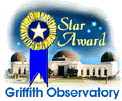|
  SPACE WEATHER SPACE WEATHER
Current
Conditions
Solar Wind
velocity: km/s
density: protons/cm3
More about these data
Updated: Today at UT
NOTE! ACE solar wind velocity measurements
are currently unreliable (too low) because the spacecraft's sensors
have been overloaded by today's proton storm. Click
here for SOHO Proton Monitor data that give a more accurate
estimate of current solar wind parameters.
Sunspot Number:
More
about sunspots
Updated:
Daily
Sun:
13
Jul 2000 
There are three sunspot
groups that pose a substantial threat for powerful solar flares.
9077 and 9070 exhibit complex beta-gamma-delta
magnetic field configurations, while 9069 has developed a somewhat
simpler beta-gamma
magnetic field.
Coronal
Holes:

There are no important
coronal holes visible in this Yohkoh soft x-ray image of the
Sun.
More about coronal holes
 SPACE WEATHER SPACE WEATHER
NOAA
Forecasts
Solar Flares: Probabilities
for a medium-sized (M-class)
or a major (X-class)
solar flare during the next 24/48 hours are tabulated below.
Updated
at
|
FLARE |
24 hr |
48 hr |
|
CLASS M |
% |
% |
|
CLASS X |
% |
% |
Geomagnetic Storms: Probabilities
for significant disturbances in Earth's magnetic field are given
for three activity levels: active,
minor storm, severe
storm
Updated
at
Mid-latitudes
|
24 hr |
48 hr |
|
ACTIVE |
% |
% |
|
MINOR |
% |
% |
|
SEVERE |
% |
% |
High latitudes
|
24 hr |
48 hr |
|
ACTIVE |
% |
% |
|
MINOR |
% |
% |
|
SEVERE |
% |
% |
|
Today
in Space --
Subscribe
to Space Weather News!
 Space
Radiation Storm: read this Science@NASA headline to
learn more about the July 14th solar flare and the coming geomagnetic
storm! [more] Space
Radiation Storm: read this Science@NASA headline to
learn more about the July 14th solar flare and the coming geomagnetic
storm! [more]
Solar Flare!
On
July 14, 2000, a powerful X5-class
solar flare from active region 9077 triggered an ongoing proton
storm in the vicinity of Earth. The explosion also produced an
Earth-directed coronal mass ejection. Material from the CME could
arrive in the neighborhood of our planet as early as Saturday,
triggering auroras and other geomagnetic disturbances.
Above: The many speckles on this ESA/NASA SOHO coronagraph
image are caused by energetic particles from the solar flare
striking the camera's CCD detector. The expanding halo around
the Sun is a fast-moving coronal mass ejection.
 The radiation
storm appears to be an S3-class event which, according to NOAA
space weather prediction scales, can cause the following effects
on satellites: single-event upsets, noise in imaging systems,
permanent damage to exposed components/detectors, and decrease
of solar panel currents. The radiation
storm appears to be an S3-class event which, according to NOAA
space weather prediction scales, can cause the following effects
on satellites: single-event upsets, noise in imaging systems,
permanent damage to exposed components/detectors, and decrease
of solar panel currents.
Above: This SOHO animation of the July 14th flare was
recorded by the spacecraft's Extreme-ultraviolet Imaging Telescope
at 195 angstroms. A larger version of
this movie
nicely shows the flare, followed by a torrent of energetic particles
that arrived about 15 minutes later, creating snow on the images
as the particles bombarded the camera's electronic detectors.
Aurora
Alert: Sky
watchers in both hemispheres are advised to watch for auroras
during nighttime hours on July 14-15. The best times to see the
Northern and Southern Lights are usually near local midnight.
Tonight's nearly-full Moon will outshine faint Northern Lights,
but intense aurora could be visible in spite of the lunar interference.
Material from a coronal mass ejection on July 11th [170
kb SOHO animation]
could
arrive in the neighborhood of our planet on July 14th. Also,
this morning's CME is expected to reach Earth by July 15th or
16th. High geomagnetic activity is expected to persist for 24
to 48 hours.
WEB
LINKS: NOAA
FORECAST
| GLOSSARY | SPACE
WEATHER TUTORIAL
| LESSON
PLANS
| MORE
NEWS
| BECOME
A SUBSCRIBER |
Space
Weather News
Become
a Subscriber!
June 22, 2000:
Coming
Soon: Better Space Storm Warnings
-- Scientists have
developed a model for predicting when coronal mass ejections
will hit Earth's magnetosphere.
June 13, 2000: From
the Drawing Board to the Stars -- In
this scientific human interest story, Dr.
Jim Burch discusses his experience as Principal Investigator
for NASA's newest space weather satellite.
June 7, 2000: Solar
Storm Warning -- a
coronal mass ejection detected on June 6, 2000, heads for Earth.
June 5, 2000: First
Light for a Space Weather Satellite
-- see electrifying
pictures from a unique weather satellite dedicated to space storms.
May 17, 2000: Dance
of the Planets -- Scientists at the Goddard Space
Flight Center used data from the ESA/NASA SOHO wide field coronagraph to
produce an
mpeg animation
of the planets aligning with the Sun from April 27 through May
15. It's a must-see!
May 16, 2000: A
Christmas Star for SOHO -- On May 17,
2000, the bright planets Venus and Jupiter passed less than 42
arcseconds apart. The spectacle, similar to the "Christmas
Star" conjunction of 2 BC, was visible in coronagraph images
from the Solar and Heliospheric Observatory.
May 9, 2000: Solar
Ups and Downs -- It was a rare sight
so near Solar Max -- the Sun was nearly featureless on May 7,
2000.
MORE SPACE WEATHER HEADLINES |
 SPACE WEATHER
SPACE WEATHER






